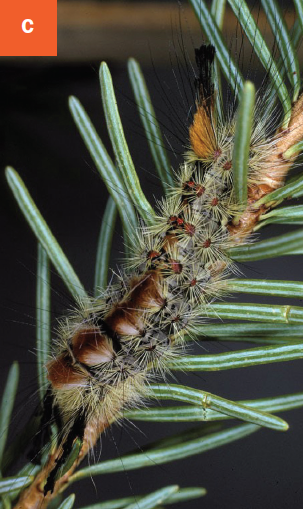Douglas-Fir Tussock Moth
Orgyia pseudotsugata
HOST Douglas-fir, spruce, fir
DAMAGE/SYMPTOMS Caterpillar feeding and defoliation typically starts on new, succulent foliage at the top of the tree and continues downward. Sometimes the defoliation can be severe, especially if occurring over repeated seasons. Caterpillars may be found under webbing and silk harborages on the branches.
LIFE CYCLE They overwinter as egg masses on twigs and branches. The eggs hatch in the spring at bud break, often in late May, and caterpillars begin feeding on the new growth. They then move to feed on older needles. Adults emerge in late summer (late July through mid-August). There is one generation per year.
MANAGEMENT A variety of predators and natural enemies normally keep populations down, including parasitic wasps, tachinid flies, spiders, and birds. If chemical control is necessary, contact insecticides are most effective during the early spring when caterpillars are younger. Monitoring for caterpillars is critical for the proper timing of insecticide applications. Some reduced-risk options for control include insecticides with the active ingredients Bacillus thuringiensis (kurstaki strain) and spinosad. Other contact insecticides include those with the active ingredients cyfluthrin, permethrin, and lambdacyhalothrin.
A Douglas-fir tussock moth cocoon. B Douglas-fir tussock moth damage. C Douglas-fir tussock moth caterpillar. D Douglas-fir tussock moth adult.




